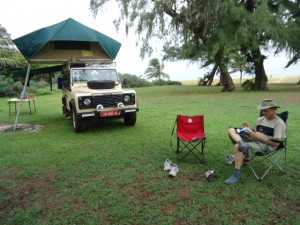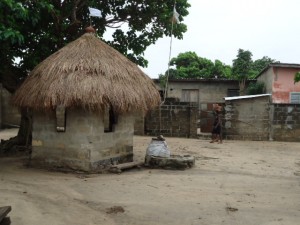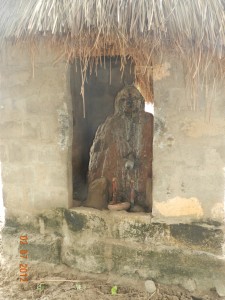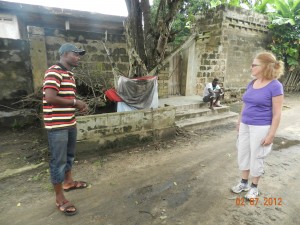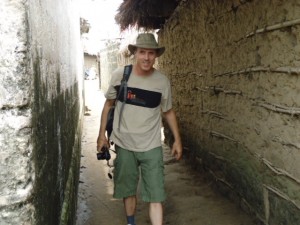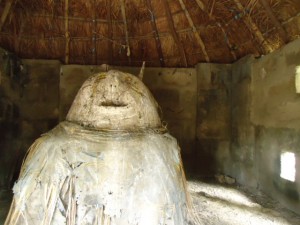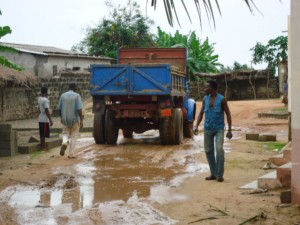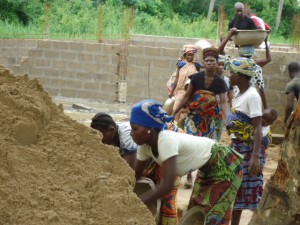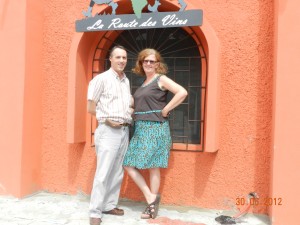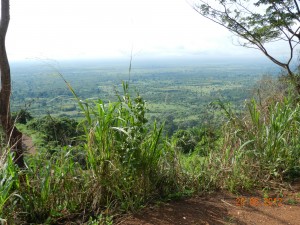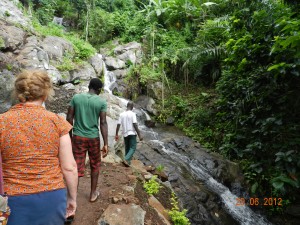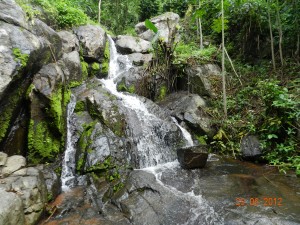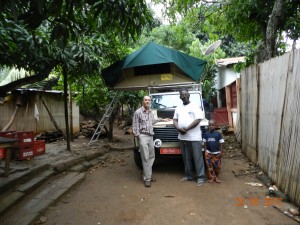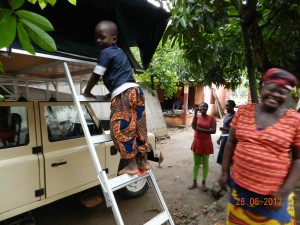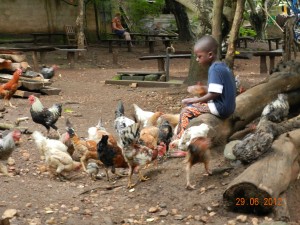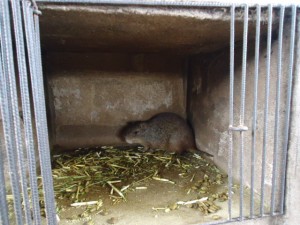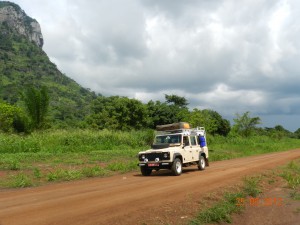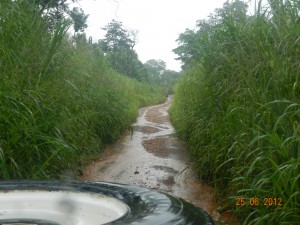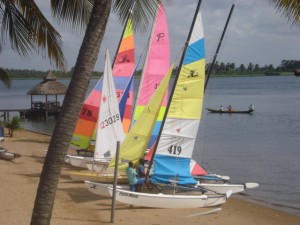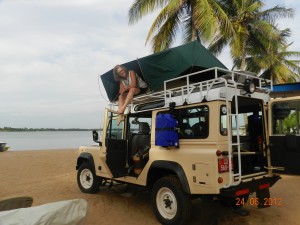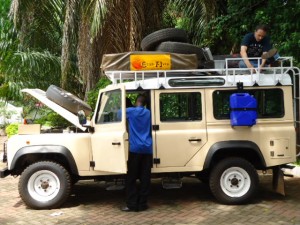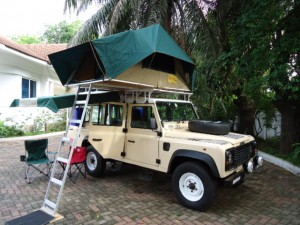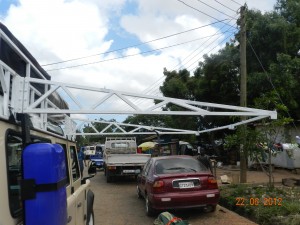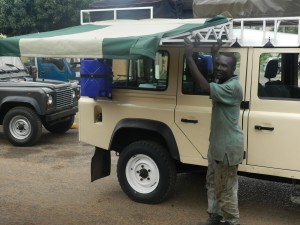So how do we get everything in the Land Rover? Laura chimes in with her comments on “overlanding”. It’s one thing to do the touristy stuff but we are living out of our Land Rover. How do we do it?
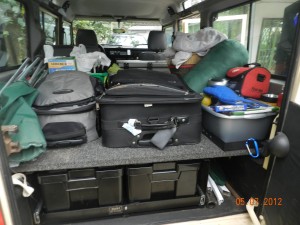 The equipment and supplies in the back of the Land Rover have been moved around a couple of times over the week and a half we have been on the road and now we seem to have things where we need them. The back of the Land Rover has been specially outfitted with 4 bins on slide out drawer rails that fit between the wheel wells. I have marked each bin lid so we know which is which. 1) Dishes 2) Pots and cooking utensils 3)Breakfast and some snacks and 4)Toiletries including malaria test kits, various antibiotics we hope not to need and the malarone tablets we are taking every day to protect against malaria. Set on top of the drawer system and the wheel wells is a plywood floor that has been carpeted. Here is where we each have our suitcase and to one side of the suitcases are the folding chairs and to the other is the plastic dish washing bin with the dish soap, sponge, tea towels and table cloth. This is also where the flashlights and fire extinguisher are kept. Then there is a box with overflow food, clothes hangers if we ever want to hang clothes to dry. (So far we have sent our washing out while in Lome. Besides which we haven’t been in one place long enough to wash and dry clothes.) and there is a basket with “activity” stuff which includes our crossword puzzles, a quilt I am beginning to piece, pens to give away when we feel charitable and a couple of books. I have my Kobo though one of the books I bought doesn’t seem to have loaded. Jonathon has tool box and a ratchet set in the middle of the floor. These have already proved useful for tightening the light on the back of the vehicle or replacing a grommet in the awning and for loan to a Togolais to repair a wheel hub on his moto.
The equipment and supplies in the back of the Land Rover have been moved around a couple of times over the week and a half we have been on the road and now we seem to have things where we need them. The back of the Land Rover has been specially outfitted with 4 bins on slide out drawer rails that fit between the wheel wells. I have marked each bin lid so we know which is which. 1) Dishes 2) Pots and cooking utensils 3)Breakfast and some snacks and 4)Toiletries including malaria test kits, various antibiotics we hope not to need and the malarone tablets we are taking every day to protect against malaria. Set on top of the drawer system and the wheel wells is a plywood floor that has been carpeted. Here is where we each have our suitcase and to one side of the suitcases are the folding chairs and to the other is the plastic dish washing bin with the dish soap, sponge, tea towels and table cloth. This is also where the flashlights and fire extinguisher are kept. Then there is a box with overflow food, clothes hangers if we ever want to hang clothes to dry. (So far we have sent our washing out while in Lome. Besides which we haven’t been in one place long enough to wash and dry clothes.) and there is a basket with “activity” stuff which includes our crossword puzzles, a quilt I am beginning to piece, pens to give away when we feel charitable and a couple of books. I have my Kobo though one of the books I bought doesn’t seem to have loaded. Jonathon has tool box and a ratchet set in the middle of the floor. These have already proved useful for tightening the light on the back of the vehicle or replacing a grommet in the awning and for loan to a Togolais to repair a wheel hub on his moto.
The guide books are kept in a basket squeezed between the back of the passenger seat and the fridge is in easy reach while traveling. There is a space under the fridge floor that runs halfway across the vehicle that is handy to store things: 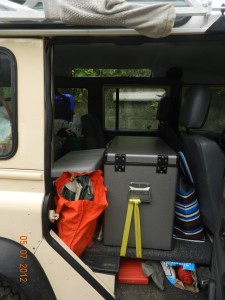 a small shovel, the emergency road alert triangle, the jack, and the long rod that makes the fourth side of the awning. We kept the single passenger seat on the other side behind the driver and when not in use for guides or other passengers it comes in handy to put day packs and other miscellaneous pieces. The awning and its poles are inside the door on the side where the awning hangs. The fridge behind the passenger seat is plugged into a specially installed plug that runs to the second battery, which is installed under the passenger seat. The fridge is big enough to hold what we need to keep cool, from milk and butter to white wine and insulin.
a small shovel, the emergency road alert triangle, the jack, and the long rod that makes the fourth side of the awning. We kept the single passenger seat on the other side behind the driver and when not in use for guides or other passengers it comes in handy to put day packs and other miscellaneous pieces. The awning and its poles are inside the door on the side where the awning hangs. The fridge behind the passenger seat is plugged into a specially installed plug that runs to the second battery, which is installed under the passenger seat. The fridge is big enough to hold what we need to keep cool, from milk and butter to white wine and insulin.
On the roof beside the tent are two more almost empty black bins (“ammo boxes”) in a waterproof traveling case. These are for the purchases we make along the road. So far they just have two jars of jam and a bag of coffee from the Benedictine Monastery. Surely there will be more to come.
It took us a couple of days to master opening the tent on the roof and putting in the metal stays that hold out the fly. I try to keep the sand out of the tent by sweeping the sheets and floor every morning. We have a mini broom and dust pan that fit in a side pocket of the tent. We hang a bag from the tent frame with our pj’s that can stay there when the tent is folded. The roof of the tent is high enough to be able to sit and read by fluorescent lantern.
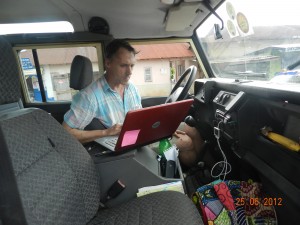
The ipods have music. The mobile speakers have new batteries. This computer can be charged using any one of the three “cigarette” lighter plugs we have wired to run off the second battery.
We have drinking water in a jerry can attached to the outside on one side, wash water in a jerry can on the other, and a propane cooking fuel canister on the back. Many people, including me, wondered about toilets. So far we have always had access to a toilet and often shower in a nearby hotel, monastery or host’s house. I do take advantage of our couple of hotel stays to wash my hair and luxuriate in a long hot shower.
We aren’t deprived – did I mention the couple of bottles of wine we have drank and replenished? As for security, all our cash, passports and other valuables are locked in a very secure hidden place that no-one will ever find, but of course I can’t tell you where it is. It’s camping comfortable. Sort of like shabby chic but with al fresco dining.

